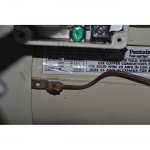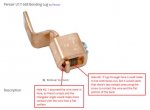Some of my equipment wasn't hooked up last fall for the simple reason that I didn't want it outside over the winter. I have probably 20' of copper wire coiled up at the pad that's connected to the bonding grid of my pool. I know that everything metallic that's connected to the water in some form needs to be bonded, like my EasyTouch Panel, my heater, my pump, and my lighting transformer.
My question is around the *method* for bonding. Most of these pieces of equipment have a single bonding lug. They don't really look like they'd take two pieces of #8 wire. When bonding is done between equipment, do people try to use a continuous piece of bare copper wire? If so, it doesn't look like that part works on my EasyTouch, as there's a bend in the bracket that hangs down and makes it look like it needs to be cut there. There's two lugs on the EasyTouch, but they're not connected, so I'm assuming that you shouldn't use one for the pool connection, and one for the rest of the loop, right? I'm curious if anyone can share a picture of their equipment. I'm trying to figure out if this is more of a continuous loop, or a hub-and-spoke type of connection between these pieces of equipment?
My question is around the *method* for bonding. Most of these pieces of equipment have a single bonding lug. They don't really look like they'd take two pieces of #8 wire. When bonding is done between equipment, do people try to use a continuous piece of bare copper wire? If so, it doesn't look like that part works on my EasyTouch, as there's a bend in the bracket that hangs down and makes it look like it needs to be cut there. There's two lugs on the EasyTouch, but they're not connected, so I'm assuming that you shouldn't use one for the pool connection, and one for the rest of the loop, right? I'm curious if anyone can share a picture of their equipment. I'm trying to figure out if this is more of a continuous loop, or a hub-and-spoke type of connection between these pieces of equipment?



